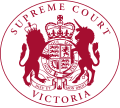Supreme Court of Victoria
Superior court of the state of Victoria, Australia From Wikipedia, the free encyclopedia
Superior court of the state of Victoria, Australia From Wikipedia, the free encyclopedia
Seamless Wikipedia browsing. On steroids.
Every time you click a link to Wikipedia, Wiktionary or Wikiquote in your browser's search results, it will show the modern Wikiwand interface.
Wikiwand extension is a five stars, simple, with minimum permission required to keep your browsing private, safe and transparent.
The Supreme Court of Victoria is the highest court in the Australian state of Victoria. Founded in 1852, it is a superior court of common law and equity, with unlimited and inherent jurisdiction within the state.
This article needs additional citations for verification. (April 2021) |
| Supreme Court of Victoria | |
|---|---|
  Emblem (left) and arms (right) of the Supreme Court | |
 | |
 | |
| 37°48′51″S 144°57′29″E | |
| Established | 1852 |
| Jurisdiction | |
| Location | Melbourne |
| Coordinates | 37°48′51″S 144°57′29″E |
| Composition method | Appointed by Governor on the advice of the Executive Council |
| Authorised by | None (inherent jurisdiction) |
| Appeals to | High Court of Australia |
| Appeals from | |
| Judge term length | Mandatory retirement by age 70 |
| Website | www.supremecourt.vic.gov.au |
| Chief Justice of Victoria | |
| Currently | The Honourable Chief Justice Anne Ferguson |
| Since | 2 October 2017 |
The Supreme Court comprises two divisions: the Trial Division, which oversees its original jurisdiction, and the Court of Appeal, which deals with its appellate jurisdiction, and is frequently referred to as a court in its own right. Although the Supreme Court is theoretically vested with unlimited jurisdiction, it generally only hears, at trial, criminal cases in instances of murder, manslaughter or treason, and civil cases where the statement of claim is in excess of the Magistrates' Court limit of $100,000.
The court hears appeals from the County Court, as well as limited appeals from the Magistrates' Court. Decisions of the Supreme Court are appealable to the High Court of Australia.
The building itself is on the Victorian Heritage Register.

The Supreme Court has two divisions - the Trial Division and the Court of Appeal.[1]
The Trial Division sits with one judge, and usually acts as a court of original jurisdiction for serious criminal matters such as murder, attempted murder, corporate offences and certain conspiracy charges, and civil matters which are considered to involve greater complexity or amounts of money more than would be appropriate to have determined in the Magistrates' Court (whose civil jurisdictional limit is $100,000)[2] or County Court (whose jurisdiction has since the beginning of 2007 been unlimited as to amount). The Trial Division also acts as an appeal court from the Magistrates' Court on questions of law, and appeals from the Victorian Civil and Administrative Tribunal on points of law, except against an order of the President or Vice-President of the Tribunal. It also hears federal indictable offences such as treason.
The Commercial Court is a sub-division of the Trial Division, composed of specialist judges to deal with commercial disputes.
The Court of Appeal hears appeals from the County Court and the Trial Division, as well as appeals on points of law from the Victorian Civil and Administrative Tribunal against the order of the President or Vice-President, and usually consists of a panel of three Judges of Appeal. In rare cases where it is sought to overrule or reconsider the correctness of a previous Court of Appeal decision, it can sit with five judges.





The main buildings for the Supreme Court are located at the corner of William and Lonsdale Streets in Melbourne and in nearby buildings.[3]
The Supreme Court also does circuits to Ballarat, Geelong, Warrnambool, Hamilton, Horsham, Bendigo, Mildura, Shepparton, Wangaratta, Wodonga, Sale and Morwell. In these locations the Court uses the facilities of the local Magistrates' Court.[3]
(appointment date in brackets):[4]